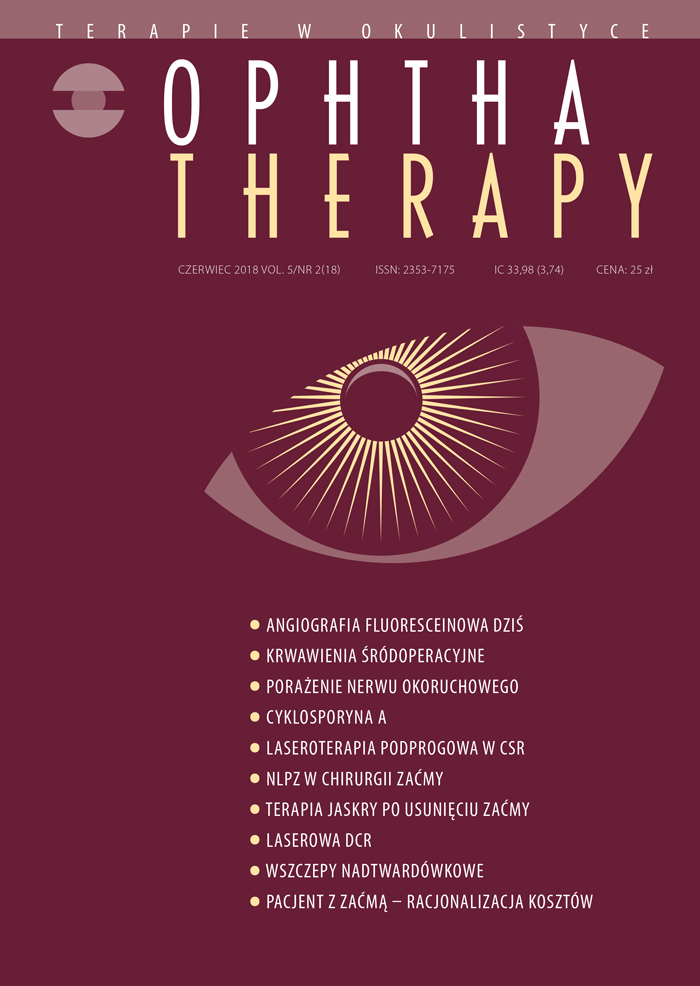Pharmacotherapy in glaucoma patients after cataract surgery ? a clinical rationale
Main Article Content
Abstract
According to the WHO, glaucoma is the second most common cause of blindness in the world after cataract and the leading cause of irreversible blindness. In an aging society, the number of glaucoma patients who require a cataract surgery increases. Phacoemulsification is the most common cataract procedure and it is important in the management of both conditions. In glaucomatous patients, postoperative intraocular pressure after cataract removal should be monitored with special attention. Recent studies suggest that phacoemulsification decreases intraocular pressure among many individuals with ocular hypertension or glaucoma and that intraocular pressure reduction is proportional to its preoperative level, we should remember about the risk of transient intraocular pressure spike in the early postoperative period, which may require additional treatment.
Downloads
Article Details

This work is licensed under a Creative Commons Attribution-NonCommercial-NoDerivatives 4.0 International License.
Copyright: © Medical Education sp. z o.o. License allowing third parties to copy and redistribute the material in any medium or format and to remix, transform, and build upon the material, provided the original work is properly cited and states its license.
Address reprint requests to: Medical Education, Marcin Kuźma (marcin.kuzma@mededu.pl)
References
2. Guan H, Mick A, Porco T et al. Preoperative factors associated with IOP reduction after cataract surgery. Optom Vis Sci. 2013; 90(2): 179-84. https://doi.org/10.1097/OPX.0b013e31827ce224.
3. Hayashi K, Hayashi H, Nakao F et al. Effect of cataract surgery on intraocular pressure control in glaucoma patients. J Cataract Refract Surg. 2001; 27(11): 1779-86.
4. Tham CC, Leung DY, Kwong YY et al. Effects of phacoemulsification versus combined phaco-trabeculectomy on drainage angle status in primary angle closure glaucoma (PACG). J Glaucoma. 2010; 19(2): 119-23. https://doi.org/10.1097/IJG.0b013e31819d5d0c.
5. Poley BJ, Lindstrom RL, Samuelson TW et al. Intraocular pressure reduction after phacoemulsification with intraocular lens implantation in glaucomatous and nonglaucomatous eyes: evaluation of a causal relationship between the natural lens and open-angle glaucoma. J Cataract Refract Surg. 2009; 35(11): 1946-55. https://doi.org/10.1016/j.jcrs.2009.05.061.
6. Wang N, Chintala SK, Fini ME et al. Activation of a tissue-specific stress response in the aqueous outflow pathway of the eye defines the glaucoma disease phenotype. Nat Med. 2001; 7(3): 304-9.
7. Meyer MA, Savitt ML, Kopitas E. The effect of phacoemulsification on aqueous outflow facility. Ophthalmology. 1997; 104(8): 1221-7
8. Dayanir V, Ozcura F, Kir E et al. Medical control of intraocular pressure after phacoemulsification. J Cataract Refract Surg. 2005; 31(3): 484-8.
9. Byrd S, Singh K. Medical control of intraocular pressure after cataract surgery. J Cataract Refract Surg. 1998; 24(11): 1493-7.
10. Borazan M, Karalezli A, Akman A et al. Effect of antiglaucoma agents on postoperative intraocular pressure after cataract surgery with Viscoat. J Cataract Refract Surg. 2007; 33(11): 1941-5.
11. Rainer G, Menapace R, Findl O et al. Effect of a fixed dorzolamide-timolol combination on intraocular pressure after small-incision cataract surgery with Viscoat. J Cataract Refract Surg. 2003; 29(9): 1748-52.
12. Georgakopoulos CD, Makri OE, Plotas P et al. Brinzolamide-timolol fixed combination for the prevention of intraocular pressure elevation after phacoemulsification. Clin Exp Ophthalmol. 2013; 41(7): 662-7. https://doi.org/10.1111/ceo.12092.
13. Ozkurt Y, Oral Y, Karacan O et al. Comparison of the effects of dorzolamide-timolol fixed combination and brimonidine on intraocular pressure after phacoemulsification surgery. Eye Contact Lens. 2008; 34(1): 21-3. https://doi.org/10.1097/ICL.0b013e3180587e0a

